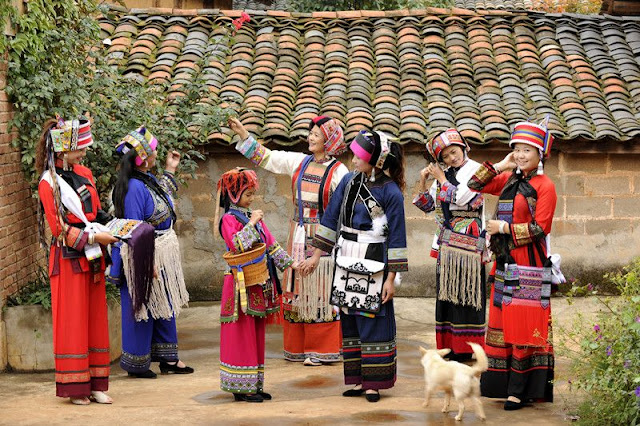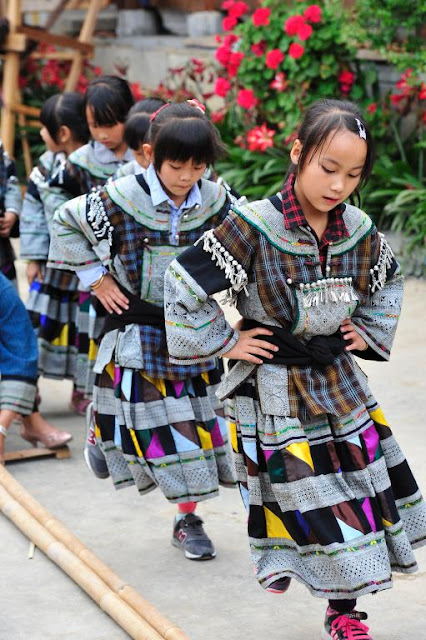Hello all,
Today I continue my coverage of the costumes of the Yi people by talking about the Sani, also called the Southeastern Yi. The people in this group live in southeastern Yunnan, fron Shilin in Kunming to the south and east, and just over the border into Guangxi. Here is a rough map of the area inhabited by this group.
Lunan style
This style of costume is worn in the northwestern parts of this area, the counties of Shilin, northern Mile and Qiubei.
Shilin or Stone Forest Yi
This costume is well known because it is worn by the Sani Yi community who live around the famous Stone Forest of Kunming. https://en.wikipedia.org/wiki/Stone_Forest

This place is very significant for the Sani, who celebrate traditional rituals in the Stone Forest, or the Forest of Ashima. Today they also give cultural perfomances for tourists in that location.
The girls' and womens' headdresses also differ in color and ornamentation. Here we see an older woman's headdress on the left, and a young woman's headdress on the right.
Pointed embroidered shoes are worn for festive occasions.
The small mantle worn over the shoulder is traditionally made with a sheepskin backing. This must be a symbolic remnant of an ancient garment.
The Sani, like all the Yi, are known for their embroidery, including cross stitch.
Here is a baby carrier from this region.
Shoulder bags are also embroidered.
Men's attire tends to be simple and plain, based on cloth woven from fire weed, Gerbera delavayi.
https://nmnh.typepad.com/the_plant_press/2018/03/preservation-of-a-chinese-plant-and-the-culture-around-it.html
The Torch festival is held in the Stone Forest on the 24th day of the 6th month. This includes many rituals including the veneration of the element of fire.
Dancing is an important part of the traditional festivals.
This is the traditional Moon Dance.

Just a few more images of this costume.
Here are a few videos of the Sani dancing.
West Mile Mountain Axi
The costume is worn in the mountainous regions of western Mile County. These people are called Axi. The costume consists of short pants, a black and white gown which is long in the back and short in the front, a short apron and a shoulder bag. The men's costume resembles that worn by the Shilin Sani.
pants
apron
sash
The bag is embroidered for young and middle aged women, and of plain knotted linen for older women.
Children wear caps to protect them that are imaginative creations.
Just a couple more images of this costume.
The Axi men celebrate the festival of fire on the third day of the second month, commemorating the story of the gift of fire to man. They paint their naked bodies red, yellow, and black, offer sacrifices and jump bonfires to remind themselves how life was like before man found fire.
Qiubei County
The Yi people in Qiubei originally came from Guishan. The costume is rather distinct. Nevertheless it resembles both of the above costumes. The old costume includes a very ornate apron pieced together from different colors of fabric.

Mile County Style
This style of costume is found to the south of the first style in south Mile County, as well as in Huaning, Luxi, Wenshan, Yanshan and part of Qiubei
This costume is characterized by a short jacket rather than a knee length gown. The apron has a bib and is highly ornamented with emvroidery, applique and silver jewelry. The headdress varies.
This version is worn in southern Mile County, in the areas of Wushanxiang, Xunjianshizhen and Jiangbianxiang.
The headdress, compare with image above.
The jacket and pants.
Apron
Another jacket from Luxi County.
Another group in Luxi County, Qiubei County and the Dongshan region of Mile County wears outfits of natural linen color with colorful cross stitch embroidery.
Here is an image of the back of a vest which is worn over the garments shown above.
Another version is worn in Dongshan district of Wenshan County. Here are the jacket, headdress, apron and leggings of that costume.
A very distinctive costume is worn in Wushan district of Mile county as well as part of neighboring Luxi. This group originally came from Zhaotong long ago. This group is known as the Azhe.
Young women wear a different type of headdress.
Wenxi Style
This style of costume is worn in the eastern part of this region, in extreme southeastern Yunnan and over the border into Pingbian County and Guangxi Province. Here is a very rough map.
These ladies are from Wenshan.

In part of Pingbian County, Honghe prefecture, from around Wantang, Baihe east to the border, this costume is worn by the Yi.
Ribbons to hang down in back.
Pieces of the headdress
Jacket, waistband and skirt
The costume worn in Xichou County relies heavily on patchwork.
This costume is worn in Maguan County. Note the similarity of the skirts to those of Malipo County.
In Malipo County the costume relies heavily on patchwork and batik ornament. This group is called the Bailuo.
Woman's jacket, headdress and skirt
These are popular with collectors.
The men's costume is also heavily batiked.
Originally the men's pants were embroidered in a similar manner to the women's skirts.
Here is a closeup of a man's jacket.
A few more images from this group.
Common to many Yi groups is the square gown, a highly ornamented ritual garment put on by the bride on the day after the wedding to greet her family.
A video showing the batik work of the Bailuo.
https://www.youtube.com/watch?v=2keOxZ6vl00
Funing County, Yunan and Napo County, Guangxi.
This costume is found in the southeasternmost county of Yunan and over the border into Guangxi. It also depends heavily on batik ornament.
The men's costume has some similarity to that of Malipo.

The women will layer garments for festive dress.
A simpler costume with a short white jacket is also used in this area.
A bark hoop covered with cloth is a traditional part of this costume.

That concludes this section of the overview of the Yi Costumes. As you can see there are more variants that I have only found hints of.
Thank you for reading, I hope that you have found this to be interesting and informative.
Roman K.
email: rkozakand@aol.com
Source Material:
Unknown Author, 'The Costumes and Adornments of Chinese Yi Nationality Picture Album', Beijing, 1990Deng Qiyao et al, 'The Folk Arts of Yunnan Ethnics', Yunnan, 1993
Chen Hongguang et al, 'Ethnic Costumes Clothing Decorations from China', Chengdu, Sichuan, 1995
Bernard Formoso, 'Costumes du Yunnan', Nanterre, 2013
Shan Ren et al, 'The Cream of Yunling - A Photo Odyssey of Yunnan Ethnic Groups', Kunming, 1998








































































































































Thank you very much for this thorough collection of indigenous clothing from the region. However, you seem to have missed a set from a place called Bainitang in Qiubei. The video covers a group who call themselves the "Guobo" and claim descent from the culture that produced the cliff coffins in the region.
ReplyDeletehttps://www.youtube.com/watch?v=aDq51btkP88